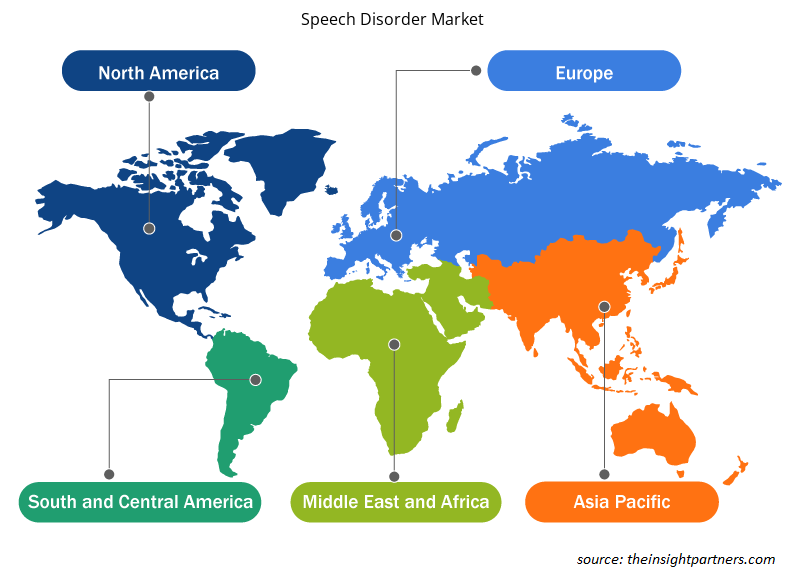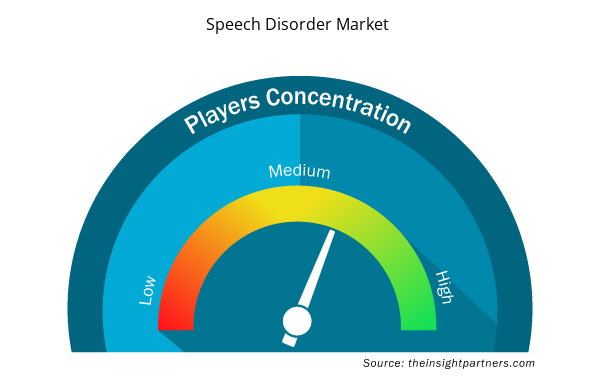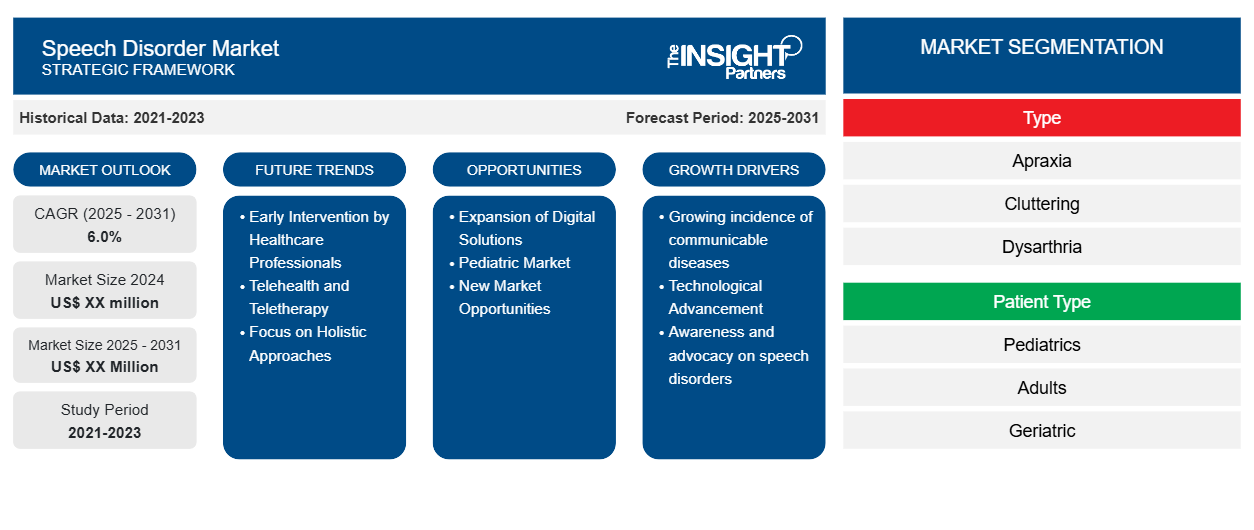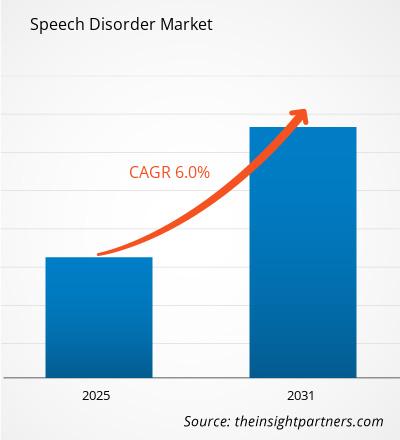Se espera que el mercado de trastornos del habla registre una CAGR del 6,0 % entre 2023 y 2031, con un tamaño de mercado que se expandirá de US$ XX millones en 2023 a US$ XX millones en 2031.
El informe está segmentado por tipo (apraxia, tartamudeo, disartria, trastorno neurológico del habla, otros) y tipo de paciente (pediatría, adultos, geriatría). El informe presenta además un análisis basado en el proveedor de servicios (hospitales y clínicas, centros especializados). El análisis global se desglosa aún más a nivel regional y por países principales. El informe ofrece el valor en USD para el análisis y los segmentos anteriores.
Propósito del Informe
El informe Speech Disorder Market de The Insight Partners tiene como objetivo describir el panorama actual y el crecimiento futuro, los principales factores impulsores, los desafíos y las oportunidades. Esto proporcionará información a diversas partes interesadas del negocio, como:
- Proveedores/fabricantes de tecnología: Para comprender la dinámica cambiante del mercado y conocer las oportunidades potenciales de crecimiento, lo que les permitirá tomar decisiones estratégicas informadas.
- Inversionistas: Realizar un análisis exhaustivo de tendencias sobre la tasa de crecimiento del mercado, las proyecciones financieras del mercado y las oportunidades que existen en toda la cadena de valor.
- Órganos reguladores: Regular las políticas y vigilar las actividades del mercado con el objetivo de minimizar los abusos, preservar la confianza de los inversores y defender la integridad y estabilidad del mercado.
Segmentación del mercado de trastornos del habla
Tipo
- Apraxia
- Desorden
- Disartria
- Trastorno neurológico del habla
- Otros
Tipo de paciente
- Pediatría
- Adultos
- Geriátrico
Proveedor de servicios
- Hospitales y Clínicas
- Centros especializados
Geografía
- América del norte
- Europa
- Asia-Pacífico
- América del Sur y Central
- Oriente Medio y África
Geografía
- América del norte
- Europa
- Asia-Pacífico
- América del Sur y Central
- Oriente Medio y África
Personalice este informe según sus necesidades
Obtendrá personalización en cualquier informe, sin cargo, incluidas partes de este informe o análisis a nivel de país, paquete de datos de Excel, así como también grandes ofertas y descuentos para empresas emergentes y universidades.
- Obtenga las principales tendencias clave del mercado de este informe.Esta muestra GRATUITA incluirá análisis de datos, desde tendencias del mercado hasta estimaciones y pronósticos.
Factores impulsores del crecimiento del mercado de trastornos del habla
- Aumento de la incidencia de enfermedades contagiosas: el crecimiento del mercado se ve impulsado por el aumento de casos de trastornos de la comunicación en niños y adultos, debido a retrasos en el desarrollo, afecciones neurológicas y poblaciones geriátricas. A medida que aumenta la conciencia sobre estos trastornos, existe una mayor necesidad de tratamientos y herramientas eficaces, lo que se traduce en que los proveedores buscan opciones de tratamiento más avanzadas.
- Avances tecnológicos: Los avances en áreas como las aplicaciones de logopedia, las plataformas de teleterapia y los dispositivos de comunicación aumentada mejoran el acceso al tratamiento. Los pacientes reciben intervenciones oportunas que les permiten tomar mejores decisiones y la demanda en el mercado está aumentando en respuesta a soluciones más efectivas y convenientes, y por lo tanto por parte de los profesionales y los pacientes.
- Concienciación y promoción de los trastornos del habla: se ha aumentado mediante campañas y educación. Las organizaciones, así como los profesionales de la salud, crean conciencia sobre la importancia del diagnóstico y la intervención tempranos que fomentan la detección, los servicios de tratamiento y los productos y terapias relacionados.
Tendencias futuras del mercado de trastornos del habla
- Intervención temprana por parte de los profesionales sanitarios: la creciente concienciación y la promoción de los trastornos del habla, principalmente a través de campañas y educación, son factores que contribuyen a la expansión del mercado. Las organizaciones y los profesionales sanitarios destacan la necesidad de un diagnóstico y una intervención tempranos, lo que, a su vez, aumenta los servicios de detección y tratamiento e impulsa la demanda de productos y terapias relacionados.
- Telesalud y teleterapia: los servicios de telesalud han transformado la forma en que se brinda la terapia del habla, ya que brindan consultas y sesiones a distancia. Esta tendencia hace que la terapia sea más accesible, por supuesto, en áreas desatendidas. El mercado de soluciones de terapia del habla en línea crecerá considerablemente en el futuro cercano, ya que los pacientes y los proveedores utilizarán cada vez más plataformas virtuales para acceder a la terapia del habla.
La práctica del mercado también evoluciona hacia la mayor personalización y adaptación posible de los planes para el tratamiento de los trastornos del habla que sean adecuados para cada individuo. La tendencia hacia la personalización y la adaptación ha estado impulsando a los profesionales de la salud a encontrar la alineación en los tratamientos a través de una evaluación basada en datos específicos con la entrega de resultados mucho mejores. La presión de esta tendencia requiere herramientas versátiles que sean adaptables, lo que, nuevamente, consolida un llamado a la innovación en el mercado. - Enfoque en enfoques holísticos: el creciente reconocimiento de la necesidad de enfoques de tratamiento holísticos está moldeando el mercado de los trastornos del habla. Las terapias se están volviendo más psicológicas, emocionales y sociales al diseñar los planes de tratamiento. Esto tiene potencial porque la atención holística se considera esencial. Por lo tanto, crea presión para que los proveedores de servicios creen soluciones integrales que aborden el bienestar de sus pacientes en su conjunto.
Oportunidades de mercado para los trastornos del habla
- Expansión de soluciones digitales: las empresas pueden aprovechar la oportunidad que ofrece la creciente demanda de herramientas digitales de logopedia. Las empresas pueden desarrollar aplicaciones, software o plataformas interactivas que permitan a los pacientes practicar en casa y recibir comentarios directos de los logopedas. También se puede ofrecer a las escuelas en coordinación con las instituciones educativas como una experiencia educativa.
- Mercado pediátrico: Debido a que los trastornos del habla suelen descubrirse durante los primeros años, el segmento pediátrico tiene un amplio margen de crecimiento. Las empresas pueden centrarse en el desarrollo de herramientas terapéuticas y recursos educativos diseñados exclusivamente para niños y utilizados por padres y educadores que buscan herramientas eficaces para el desarrollo y la mejora del habla.
- Nuevas oportunidades de mercado: Se pueden aprovechar nuevas oportunidades de mercado si se llega a los mercados rurales y desatendidos. Será útil ampliar el acceso al tratamiento de los trastornos del habla en estas áreas mediante el uso de clínicas móviles, servicios de teleterapia y programas de extensión comunitaria. Las empresas que se centran en ofertas accesibles y asequibles están bien posicionadas para captar eficazmente este segmento en crecimiento.
Perspectivas regionales del mercado de trastornos del habla
Los analistas de Insight Partners explicaron en detalle las tendencias y los factores regionales que influyen en el mercado de trastornos del habla durante el período de pronóstico. Esta sección también analiza los segmentos y la geografía del mercado de trastornos del habla en América del Norte, Europa, Asia Pacífico, Oriente Medio y África, y América del Sur y Central.

- Obtenga datos regionales específicos para el mercado de trastornos del habla
Alcance del informe de mercado sobre trastornos del habla
| Atributo del informe | Detalles |
|---|---|
| Tamaño del mercado en 2023 | XX millones de dólares estadounidenses |
| Tamaño del mercado en 2031 | US$ XX millones |
| CAGR global (2023 - 2031) | 6.0% |
| Datos históricos | 2021-2022 |
| Período de pronóstico | 2024-2031 |
| Segmentos cubiertos | Por tipo
|
| Regiones y países cubiertos | América del norte
|
| Líderes del mercado y perfiles de empresas clave |
|
Densidad de actores del mercado de trastornos del habla: comprensión de su impacto en la dinámica empresarial
El mercado de los trastornos del habla está creciendo rápidamente, impulsado por la creciente demanda de los usuarios finales debido a factores como la evolución de las preferencias de los consumidores, los avances tecnológicos y una mayor conciencia de los beneficios del producto. A medida que aumenta la demanda, las empresas amplían sus ofertas, innovan para satisfacer las necesidades de los consumidores y aprovechan las tendencias emergentes, lo que impulsa aún más el crecimiento del mercado.
La densidad de actores del mercado se refiere a la distribución de las empresas o firmas que operan dentro de un mercado o industria en particular. Indica cuántos competidores (actores del mercado) están presentes en un espacio de mercado determinado en relación con su tamaño o valor total de mercado.
Las principales empresas que operan en el mercado de trastornos del habla son:
- Terapia del habla inteligente
- Terapias de referencia
- Habla Plus
- Soluciones terapéuticas Inc.
- Patología del habla Glenda Browne
Descargo de responsabilidad : Las empresas enumeradas anteriormente no están clasificadas en ningún orden particular.

- Obtenga una descripción general de los principales actores clave del mercado de trastornos del habla
Puntos de venta clave
- Cobertura integral: el informe cubre de manera integral el análisis de productos, servicios, tipos y usuarios finales del mercado de trastornos del habla, proporcionando un panorama holístico.
- Análisis de expertos: el informe se compila sobre la base de un profundo conocimiento de expertos y analistas de la industria.
- Información actualizada: El informe asegura relevancia comercial debido a su cobertura de información reciente y tendencias de datos.
- Opciones de personalización: este informe se puede personalizar para satisfacer los requisitos específicos del cliente y adaptarse adecuadamente a las estrategias comerciales.
Por lo tanto, el informe de investigación sobre el mercado de los trastornos del habla puede ayudar a abrir camino para descifrar y comprender el escenario de la industria y las perspectivas de crecimiento. Si bien puede haber algunas preocupaciones válidas, los beneficios generales de este informe tienden a superar las desventajas.
- Análisis histórico (2 años), año base, pronóstico (7 años) con CAGR
- Análisis PEST y FODA
- Tamaño del mercado Valor/volumen: global, regional, nacional
- Industria y panorama competitivo
- Conjunto de datos de Excel



Report Coverage
Revenue forecast, Company Analysis, Industry landscape, Growth factors, and Trends

Segment Covered
This text is related
to segments covered.

Regional Scope
North America, Europe, Asia Pacific, Middle East & Africa, South & Central America

Country Scope
This text is related
to country scope.
Preguntas frecuentes
The speech disorder market is estimated to grow with a CAGR of 7.0% from 2023 to 2031.
Asia-Pacific region is likely to witness the fastest growth rate during the forecast period.
The market drivers include the growing incidence of communications disorders and advances in areas such as speech therapy apps, platforms for teletherapy, and augmented communication devices improve access to the treatment are driving the Speech disorder market
Personalization and tailoring of plans for speech disorder treatment is likely to remain the key trend during the forecast period
The speech disorder market majorly consists of players such as Smart Speech Therapy, Benchmark Therapies, Speech Plus among others
North America dominated the Speech disorder market in 2023
Trends and growth analysis reports related to Life Sciences : READ MORE..
The List of Companies
1. Smart Speech Therapy
2. Benchmark Therapies
3. Speech Plus
4. Therapy Solutions Inc.
5. Glenda Browne Speech Pathology
6. Great Speech Inc.
7. Integrated Treatment Services
8. Speechagain Inc.
9. Speech Therapy Centres Of Canada
10. Agape Speech Therapy, LLC.
The Insight Partners performs research in 4 major stages: Data Collection & Secondary Research, Primary Research, Data Analysis and Data Triangulation & Final Review.
- Data Collection and Secondary Research:
As a market research and consulting firm operating from a decade, we have published and advised several client across the globe. First step for any study will start with an assessment of currently available data and insights from existing reports. Further, historical and current market information is collected from Investor Presentations, Annual Reports, SEC Filings, etc., and other information related to company’s performance and market positioning are gathered from Paid Databases (Factiva, Hoovers, and Reuters) and various other publications available in public domain.
Several associations trade associates, technical forums, institutes, societies and organization are accessed to gain technical as well as market related insights through their publications such as research papers, blogs and press releases related to the studies are referred to get cues about the market. Further, white papers, journals, magazines, and other news articles published in last 3 years are scrutinized and analyzed to understand the current market trends.
- Primary Research:
The primarily interview analysis comprise of data obtained from industry participants interview and answers to survey questions gathered by in-house primary team.
For primary research, interviews are conducted with industry experts/CEOs/Marketing Managers/VPs/Subject Matter Experts from both demand and supply side to get a 360-degree view of the market. The primary team conducts several interviews based on the complexity of the markets to understand the various market trends and dynamics which makes research more credible and precise.
A typical research interview fulfils the following functions:
- Provides first-hand information on the market size, market trends, growth trends, competitive landscape, and outlook
- Validates and strengthens in-house secondary research findings
- Develops the analysis team’s expertise and market understanding
Primary research involves email interactions and telephone interviews for each market, category, segment, and sub-segment across geographies. The participants who typically take part in such a process include, but are not limited to:
- Industry participants: VPs, business development managers, market intelligence managers and national sales managers
- Outside experts: Valuation experts, research analysts and key opinion leaders specializing in the electronics and semiconductor industry.
Below is the breakup of our primary respondents by company, designation, and region:

Once we receive the confirmation from primary research sources or primary respondents, we finalize the base year market estimation and forecast the data as per the macroeconomic and microeconomic factors assessed during data collection.
- Data Analysis:
Once data is validated through both secondary as well as primary respondents, we finalize the market estimations by hypothesis formulation and factor analysis at regional and country level.
- Macro-Economic Factor Analysis:
We analyse macroeconomic indicators such the gross domestic product (GDP), increase in the demand for goods and services across industries, technological advancement, regional economic growth, governmental policies, the influence of COVID-19, PEST analysis, and other aspects. This analysis aids in setting benchmarks for various nations/regions and approximating market splits. Additionally, the general trend of the aforementioned components aid in determining the market's development possibilities.
- Country Level Data:
Various factors that are especially aligned to the country are taken into account to determine the market size for a certain area and country, including the presence of vendors, such as headquarters and offices, the country's GDP, demand patterns, and industry growth. To comprehend the market dynamics for the nation, a number of growth variables, inhibitors, application areas, and current market trends are researched. The aforementioned elements aid in determining the country's overall market's growth potential.
- Company Profile:
The “Table of Contents” is formulated by listing and analyzing more than 25 - 30 companies operating in the market ecosystem across geographies. However, we profile only 10 companies as a standard practice in our syndicate reports. These 10 companies comprise leading, emerging, and regional players. Nonetheless, our analysis is not restricted to the 10 listed companies, we also analyze other companies present in the market to develop a holistic view and understand the prevailing trends. The “Company Profiles” section in the report covers key facts, business description, products & services, financial information, SWOT analysis, and key developments. The financial information presented is extracted from the annual reports and official documents of the publicly listed companies. Upon collecting the information for the sections of respective companies, we verify them via various primary sources and then compile the data in respective company profiles. The company level information helps us in deriving the base number as well as in forecasting the market size.
- Developing Base Number:
Aggregation of sales statistics (2020-2022) and macro-economic factor, and other secondary and primary research insights are utilized to arrive at base number and related market shares for 2022. The data gaps are identified in this step and relevant market data is analyzed, collected from paid primary interviews or databases. On finalizing the base year market size, forecasts are developed on the basis of macro-economic, industry and market growth factors and company level analysis.
- Data Triangulation and Final Review:
The market findings and base year market size calculations are validated from supply as well as demand side. Demand side validations are based on macro-economic factor analysis and benchmarks for respective regions and countries. In case of supply side validations, revenues of major companies are estimated (in case not available) based on industry benchmark, approximate number of employees, product portfolio, and primary interviews revenues are gathered. Further revenue from target product/service segment is assessed to avoid overshooting of market statistics. In case of heavy deviations between supply and demand side values, all thes steps are repeated to achieve synchronization.
We follow an iterative model, wherein we share our research findings with Subject Matter Experts (SME’s) and Key Opinion Leaders (KOLs) until consensus view of the market is not formulated – this model negates any drastic deviation in the opinions of experts. Only validated and universally acceptable research findings are quoted in our reports.
We have important check points that we use to validate our research findings – which we call – data triangulation, where we validate the information, we generate from secondary sources with primary interviews and then we re-validate with our internal data bases and Subject matter experts. This comprehensive model enables us to deliver high quality, reliable data in shortest possible time.


 Obtenga una muestra gratuita de este informe
Obtenga una muestra gratuita de este informe